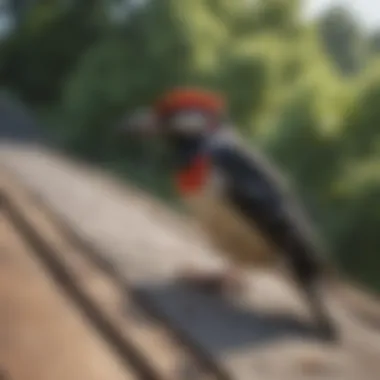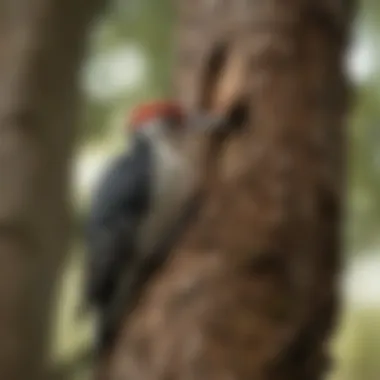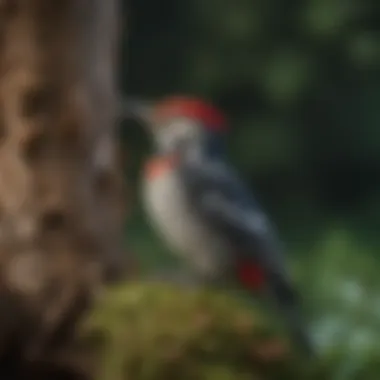Effective Strategies to Deter Woodpeckers from Your Roof


Intro
Woodpeckers are a fascinating part of the avian world, yet their persistent drumming can lead to considerable distress for homeowners. Understanding woodpeckers and their behavior is essential to address the disturbances they cause. This article delves deeply into effective strategies to deter woodpeckers, examining behavioral motivations and practical solutions. The aim is to provide sustainable methods that are in harmony with the environment, addressing the concerns of those who wish to have peaceful homes.
Understanding Pests
Definition of Pests
In ecological terms, pests are organisms that cause damage to human property or interfere with daily life. Woodpeckers can be classified as such when their activities lead to roof damage, which can escalate into costly repairs.
Importance of Pest Identification
Identifying the root causes of woodpecker activity plays a pivotal role in developing effective control measures. Understanding species behavior and motivations empowers homeowners to adapt their strategies accordingly.
Prevention Techniques
Home and Garden Preventative Measures
There are several ways to deter woodpeckers from invading your space. Some preventative measures include:
- Installing bird spikes: These reduce the chances of woodpeckers landing on your roof.
- Hanging reflective objects: Items such as aluminum foil strips or old CDs can create movement and light reflections, scaring the birds away.
- Using noise deterrents: Wind chimes or other sound-producing objects can disrupt the quiet space woodpeckers prefer.
Seasonal Prevention Tips
Seasonal changes can influence woodpecker behavior. Implementing seasonal strategies can be more effective:
- In spring, when woodpeckers are more likely to seek nesting spots, show prevention methods.
- During autumn, consider sealing potential nesting cavities in addition to making deterrents permanent.
Eco-Friendly Pest Control Solutions
Overview of Sustainable Practices
Adopting eco-friendly controls ensures that you coexist with local wildlife. This does not just preserve the woodpecker population; it also fosters a healthy environment for other species. Methods include:
- Avoiding chemical repellents that can harm birds.
- Utilizing physical barriers that provide both deterrent and protection.
Natural Remedies and Their Effectiveness
Many natural remedies have shown efficacy against woodpeckers. Some recommendations include:
- Spicy pepper sprays: When applied to wooden surfaces, these sprays can discourage birds.
- Garlic powder: Sprinkling garlic around treated areas can serve as another natural deterrent.
"Understanding the habits and motivations of woodpeckers can significantly enhance the effectiveness of your deterrent strategies."
Prelims
Woodpeckers can cause considerable damage to homes, especially when they take an interest in roofs. Understanding the importance of effective strategies to deter these birds is essential for homeowners. This article aims to equip readers not just with remedies but also with a deeper understanding of woodpecker behavior and motivations.
The significance of the topic lies in several critical areas. Firstly, woodpeckers can be persistent; if they find food or suitable nesting spots on a roof, they may return, causing continual disturbances. Such behavior not only leads to physical damage but may also affect the aesthetics of a home and lower property values over time. Homeowners need to address these issues proactively to prevent extended damage.
Secondly, incorporating effective deterrent methods can save homeowners substantial financial costs associated with repairs after woodpecker activities. When these birds peck away at the wooden structures on the roof, they can create holes and weaken the materials, potentially leading to more severe repair needs in the future. Consequently, deterring these birds is also an investment in safeguarding the integrity of a property.
Additionally, it is worth noting the ecological considerations surrounding woodpecker management. Many species of woodpeckers are protected, and using some deterrence methods could lead to legal consequences. Therefore, knowledge of safe, effective, and legal strategies is paramount.
In summary, addressing woodpecker issues proactively not only protects the physical state of a home but also ensures compliance with wildlife protection laws. This article will explore various methods to keep woodpeckers at bay, focusing on both practical approaches and sustainable practices that homeowners can integrate into their routine maintenance.


Understanding Woodpecker Behavior
Understanding the behavior of woodpeckers is essential in developing effective strategies to keep them off your roof. Woodpeckers are not just random nuisances; they are driven by specific needs and instincts that influence their actions. By comprehending these aspects, homeowners can better tailor their deterrent measures to align with the reality of woodpecker habits.
Species Identification
Correctly identifying the species of woodpeckers is crucial. Several species can frequent residential areas, including the Downy Woodpecker and the Northern Flicker. Different species have unique behaviors and preferences. For example, the Northern Flicker tends to feed on ants and beetles found on the ground, whereas the Downy Woodpecker prefers to forage on tree trunks for aphids and larvae. Recognizing these differences can guide appropriate responses. Homeowners should observe the size, coloration, and sounds of the woodpecker to identify the specific type and understand its feeding behavior, which in turn can inform effective deterrents.
Natural Habitat Preferences
Woodpeckers typically favor habitats that offer abundant food sources and suitable nesting sites. They thrive in wooded areas or places with large trees. Urban environments that provide these conditions attract them, especially if they find rotting wood or insects present in homes. Identifying these habitats can assist homeowners in modifying their surroundings. For instance, removing dead trees or maintaining tree health can lessen the appeal.
Feeding Habits
The feeding habits of woodpeckers often drive their choice of areas to inhabit. These birds primarily feed on wood-boring insects that reside in tree bark, but they can also be attracted to homes where wood is present. This behavior can lead to annoying pecking noises and potential damage. Homeowners should be aware of this and take actions such as sealing any cracks or crevices in wood structures to minimize access to these pests. Using insect repellents around the home can also deter woodpeckers by limiting their food sources.
Mating and Nesting Practices
The mating and nesting practices of woodpeckers are yet another factor to consider. Most woodpeckers start nesting in late winter to early spring. Males usually drum on surfaces to attract females and establish territory. Understanding this pattern can help homeowners anticipate times when woodpeckers may become more active around their homes. Creating environments that are less attractive for nesting, such as avoiding soft wood or placing barriers in visible areas, can minimize the likelihood of woodpeckers choosing your roof as a nesting site.
By grasping the behavioral patterns of woodpeckers, homeowners can proactively deter these birds through appropriate and timely interventions.
Why Woodpeckers Choose Roofs
Understanding the reasons behind woodpeckers' attraction to roofs is crucial for effective deterrence. Woodpeckers are not random visitors; their behaviors are influenced by specific environmental factors and their biological needs. Recognizing why these birds select roofs can help homeowners prevent damage and create a more peaceful living environment.
Availability of Food Sources
Woodpeckers primarily feast on insects, particularly wood-boring beetles and larvae. Roofs, especially those made from wood, can unintentionally provide these food sources, often found beneath the surface. The presence of soft, decaying wood attracts woodpeckers searching for a meal. Additionally, homes surrounded by trees may harbor insects, which can lead the birds to their roofs in search of easy access to food.
Homeowners can mitigate this by regularly inspecting for pest infestations. If they discover wood-boring insects or damage, addressing these issues promptly can reduce woodpecker visits. Regular extermination and proper maintenance can keep roofs less appealing to these birds.
Suitable Nesting Sites
Roofs offer ideal nesting sites for woodpeckers, especially those that are older or have loose shingles. The spaces between shingles or roof beams can resemble the cavities they create in trees for nesting. Many woodpecker species feel secure in these elevated settings, away from ground predators. Homeowners need to consider how their roof’s structure impacts its attractiveness for nesting.
To discourage nesting, homeowners can seal potential nesting sites with durable materials. Keeping rooves in good repair will reduce nooks and crannies that might serve as suitable locations. It is essential to maintain shingles and trim back overhanging branches, as these can provide access points for woodpeckers.
Environmental Conditions Favoring Woodpeckers
Environmental factors play a significant role in woodpecker presence on roofs. Warmer climates may lead to increased woodpecker activity as they search for food more aggressively. Additionally, urban areas that provide the necessary resources—like food and potential nesting sites—can attract woodpeckers more often than rural settings.
Natural seasonal changes also affect woodpecker behavior. During spring, woodpeckers are particularly active in search of mates and nesting spots. Upkeep of the home’s exterior and avoiding conditions that attract insects during these times are key strategies. For example, excess moisture on roofs can create an inviting habitat for wood-boring insects.
Understanding these factors is important because it informs strategies for removing woodpeckers and preventing their return.
By addressing food sources, nesting opportunities, and environmental conditions, homeowners can create a less appealing environment for woodpeckers. This understanding is a critical aspect of integrating effective woodpecker deterrence strategies within home maintenance.
Physical Deterrents
Physical deterrents play a crucial role in managing woodpecker issues. These strategies focus on creating barriers and altering the environment to make roofs less appealing to these birds. Effective physical deterrents reduce the likelihood of woodpeckers causing damage while promoting a bird-friendly atmosphere. Understanding which methods to implement can save homeowners both time and money on repairs.
Roof Modification Techniques
Making modifications to your roof can significantly decrease the chances of woodpecker visits. One of the most effective strategies is to apply an exterior roofing material that is less attractive to woodpeckers. For example, materials like metal and slate are more durable and harder for woodpeckers to penetrate compared to softer woods. Applying a texture or a surface coating that disrupts their pecking may also help.
It’s advisable to seal any cracks or holes on the roof. Woodpeckers often seek out areas where they can easily chip away at materials. By reinforcing weak spots, you can discourage their interest.


Installation of Netting and Screens
Using physical barriers such as netting can be very effective in preventing woodpeckers from accessing roofs. Heavy-duty plastic netting is a popular choice. When installed correctly, it creates a barrier that woodpeckers cannot easily penetrate. Ensure the netting is taut and covers potential landing spots.
Screens, particularly those made from metal, serve a similar purpose. They can be added around areas where woodpeckers tend to peck, like vents or chimney tops. This approach not only protects your roof but also allows for airflow, maintaining the home’s ventilation system without compromising on aesthetics.
Reflective Surfaces and Sounds
Utilizing reflective surfaces is another way to deter woodpeckers effectively. Items like aluminum foil or reflective tape can be hung from your roof to create visual disturbances. The light reflection causes confusion and prompts woodpeckers to look for other feeding areas.
Incorporating sounds and electronic devices that simulate predator calls can also aid in discouraging woodpeckers. Devices that emit sounds can be particularly useful, but ensure they are set to levels that do not disturb other residents. Regularly changing the location and type of sound can keep the woodpeckers from getting used to the deterrent.
It is essential to combine these methods with an understanding of the local woodpecker species, as different strategies may work better for different types of birds.
Biological and Eco-Friendly Solutions
In the quest to deter woodpeckers from your roof, incorporating biological and eco-friendly solutions emerges as a key strategy. This approach not only addresses the problem effectively but also considers the ecological impact of deterrent methods. Utilizing natural resources to repel these birds aligns with sustainable practices, fostering harmony between homeowners and wildlife. By opting for biological solutions, one minimizes the risk of harming the environment and promotes biodiversity.
Natural deterrents can be quite beneficial. They not only help in keeping woodpeckers at bay but also prevent any long-term damage to the ecosystem. These methods are often less invasive and can lead to more sustainable outcomes compared to traditional pesticides or harmful chemical sprays. Therefore, understanding and implementing biological and eco-friendly strategies can be advantageous for both your home and the environment.
Using Natural Repellents
Natural repellents are an effective way to keep woodpeckers from damaging your roof. These substances can be derived from various organic sources, which may be less harmful to other wildlife and beneficial insects. Some commonly recommended natural repellents include:
- Cayenne Pepper: Sprinkling cayenne pepper around areas where woodpeckers feed or nest can create an unpleasant experience for them without causing any harm.
- Garlic Spray: The strong odor of garlic is often unappealing to woodpeckers. Preparing a garlic spray and applying it to your roof may help deter them.
- Predator Urine: The scent of predator urine can serve as a warning signal to woodpeckers, prompting them to avoid an area. This can be purchased from various retailers focusing on pest control.
When using natural repellents, it is essential to reapply them regularly, especially after rainfall, to maintain their effectiveness. Moreover, ensure that any repellents used are compliant with local wildlife regulations.
Planting Strategies to Distract Woodpeckers
Another effective tactic is to implement planting strategies to distract woodpeckers from your roof altogether. Different plants can serve to divert their attention away from your home. Consider these options:
- Berry-Producing Bushes: Planting species such as mulberry or elderberry can attract woodpeckers to these natural food sources instead of your roof.
- Native Trees: Incorporating trees that are native to your area can support local wildlife while providing food for woodpeckers, thus reducing their interest in your home.
Avoid planting trees that attract insects, as woodpeckers may still be drawn to properties with an abundance of pests. Implementing such strategies enhances your yard's biodiversity and creates a more appealing habitat for various species, potentially reducing woodpecker visits to your house.
Understanding Ecosystems and Biodiversity
Taking a holistic view of your yard's ecosystem can also aid in woodpecker deterrence. By grasping the principles of biodiversity, you create an environment where no single species dominates, leading to a balanced ecosystem. Here are few key points to consider:
- Natural Predators: Encouraging the presence of natural predators, like hawks, can help control woodpecker populations in your area.
- Healthy Soil and Plant Diversity: Healthy soil leads to a diverse plant life, which in turn supports a variety of insects and birds. A thriving garden can reduce the number of pests that attract woodpeckers, ultimately discouraging their presence.
- Sustainable Practices: Utilizing composting, native plants, and water-efficient gardening can promote a thriving ecosystem, which serves multiple purposes.
By understanding the broader ecological context, homeowners can make informed decisions about how best to manage woodpecker populations in a way that respects both the environment and local wildlife. In doing so, you not only protect your roof but also contribute positively to the ecosystem.
Integrating Woodpecker Deterrence into Home Maintenance
Integrating woodpecker deterrence into home maintenance is crucial for homeowners who wish to protect their roofs effectively. This approach demonstrates a proactive method of addressing potential damage by combining awareness with practical strategies. By incorporating woodpecker deterrent measures into regular home maintenance schedules, homeowners can minimize the risk of these birds becoming frequent visitors.
Routine attention plays a significant role in identifying early signs of woodpecker activity. Recognizing their presence can lead to timely interventions, saving both costs and frustration in the long run. Additionally, this integration educates homeowners about the value of coexistence and respecting wildlife, which fosters a greater understanding of ecological harmony.
Timing and Home Assessment
Timing is an essential factor in integrating woodpecker deterrence. Homeowners should assess their roofs at certain times of the year, particularly in spring and summer when woodpeckers are most active in nesting and feeding. Conducting a detailed assessment involves looking for signs of distress on the roof, such as small holes or dents caused by pecking.
Keeping a close watch on these indicators helps in deciding when to implement deterrent measures. Early detection allows homeowners to act before woodpeckers settle in. In contrast, neglecting this can lead to extensive damage that could result in costly repairs.
Routine Inspection and Maintenance Tips


Regular inspection and maintenance are foundational to effective woodpecker deterrence. Homeowners should develop a habit of checking their roofs and surrounding areas for any woodpecker activity. Here are some maintenance tips:
- Inspect your roof for damage or signs of pecking.
- Clear away debris that might attract insects, a primary food source for woodpeckers.
- Trim any overhanging branches that provide access to the roof.
- Check gutters and downspouts to ensure they are functioning properly, as stagnant water can attract insects.
Additionally, maintaining the overall condition of the roof through routine cleanings and repairs discourages woodpeckers from considering it a nesting site. This proactive approach stands to benefit homeowners greatly.
Seasonal Considerations for Deterrent Approaches
Seasonality plays a critical role in how homeowners should approach woodpecker deterrence strategies. During the breeding season, which can vary by region, these birds become more territorial. Homeowners must adapt their strategies according to the season.
In early spring, it may be beneficial to install physical barriers to prevent nesting. Conversely, in late summer and early fall, repairing any existing damage becomes a priority as these birds may be looking for ideal places to prepare for winter. It is also essential to employ reflective surfaces or sound deterrents during this period, as these can startle woodpeckers into choosing other locations.
In summary, integrating woodpecker deterrence into home maintenance involves careful timing, regular inspections, and awareness of seasonal trends. This systematic approach not only protects the property but also contributes to the broader goal of maintaining an ecological balance.
Legal Considerations
The interaction between homeowners and woodpeckers introduces significant legal elements that must be recognized. Understanding the legal framework surrounding wildlife protection is crucial to ensuring homeowners act responsibly and legally when attempting to deter these birds. Ignorance of the laws can lead not only to fines but also to ethical implications regarding the treatment of wildlife. This section explores important topics related to legal considerations which will facilitate informed decision-making when addressing woodpecker issues on roofs.
Understanding Wildlife Protection Laws
Wildlife protection laws vary significantly depending on the region. In many places, woodpeckers are protected under the Migratory Bird Treaty Act in the United States. This act makes it illegal to harm, capture, or kill birds that are protected. Homeowners must be particularly cautious about the methods they choose to deter woodpeckers. Understanding these laws is essential for two main reasons:
- Compliance: Homeowners must familiarize themselves with both federal and state regulations to avoid legal repercussions. Knowledge of local laws provides a framework for permissible actions.
- Conservation: These laws aim to protect avian populations and their habitats. Respecting these guidelines contributes to the conservation of biodiversity.
To ensure better understanding, homeowners can refer to local government resources or wildlife organizations for specific regulations relevant to their area. Additional resources like Wikipedia and Britannica provide foundational information regarding wildlife laws.
Consequences of Illegal Deterrents
Using illegal methods to deter woodpeckers can lead to various consequences that extend beyond legal penalties. The repercussions may include:
- Fines and Penalties: Violating wildlife protection laws can lead to significant fines. The severity of penalties often correlates with the nature of the infraction.
- Environmental Impact: Illegal deterrents may cause unintended harm to the environment or other wildlife. For example, certain chemicals can also affect non-target species, leading to ecological imbalances.
- Public Backlash: Employing harmful deterrents can damage reputations within the community. Homeowners may face criticism from neighbors, especially if the deterrents contravene local conservation efforts.
In summary, recognizing and adhering to wildlife protection laws is paramount. Homeowners should avoid methods that break these laws, choosing instead to implement environmentally sustainable practices that respect wildlife.
It is critical to prioritize ethical treatment of wildlife while safeguarding your home.
End
In this article, we have examined various strategies to effectively deter woodpeckers from roofs. Understanding the behavior, motivations, and the implications of their presence can significantly help homeowners manage these birds.
The key elements of effective deterrence include not only physical barriers such as netting and reflective surfaces but also eco-friendly biological strategies that respect the broader ecosystem. Utilizing natural repellents and distraction through planting can provide a holistic approach.
There are several benefits associated with implementing these strategies:
- Maintaining Structural Integrity: Woodpeckers can cause extensive damage to roofing materials. Effective deterrence protects your home from costly repairs.
- Respecting Wildlife: Many woodpecker species are protected by law. Understanding and abiding by regulations ensure that your actions are ethically sound, preventing potential legal consequences.
- Eco-Friendly Solutions: Using ecological strategies fosters a healthier environment. It promotes a balance between human habitation and wildlife habitation, which is increasingly vital in suburban and urban landscapes.
Moreover, attention to seasonal conditions and the timing of deterrent methods can increase their effectiveness. Regular inspections and maintenance of both the home and the strategies used create an ongoing shield against woodpecker invasions.
Further Reading and Resources
Understanding the role of woodpeckers in our ecosystem and the resulting interactions with our homes is crucial. Effective strategies for deterring woodpeckers from roofs require not just practical solutions but also an informed perspective on these birds.
Importance of Further Reading
- Educating Yourself: Knowledge is power. Further reading allows homeowners to become familiar with woodpecker behavior, which can be useful in developing effective deterrent strategies. For example, understanding their feeding habits can guide the implementation of specific physical barriers.
- Understanding Ecological Impact: Reading up on woodpeckers helps discern the ecological implications of both their presence and our deterrent methods. Homeowners should strive to make choices that deter unwanted behavior while promoting overall environmental health.
- Legal Framework: Familiarity with wildlife protection laws is important. Many resources provide insight on legal repercussions for harming protected species. This ensure that homeowners act responsibly in their efforts to manage woodpecker populations.
- Building Community Knowledge: Engaging with communities online, such as on platforms like Reddit or Facebook, can yield anecdotal advice and experiences from homeowners who have faced similar issues. Shared experiences can lead to discovering unexpected solutions or shared strategies.
- Accessing Expert Advice: While articles can provide foundational knowledge, seeking resources from organizations such as wildlife conservation groups can offer specialized guidance and insight. Experts can furnish detailed information about biological and eco-friendly strategies that align with deterrent approaches.
Recommended Resources
- Wikipedia: Offers an overview of interactions between woodpeckers and their environment. This is a good starting point for basic knowledge. (en.wikipedia.org)
- Britannica: Provides articles on woodpecker species, habitats, and behaviors, serving as a comprehensive source for academic insight. (britannica.com)
- Reddit Communities: Engage with user-generated content discussing personal experiences and solutions regarding woodpecker deterrence. (reddit.com)
- Facebook Groups: Connect with locals or groups focused on home and garden care, where discussions regarding pest management frequently occur. (facebook.com)
The End
Further reading and resources hold significant value in understanding and implementing effective strategies against woodpeckers. By equipping themselves with knowledge, homeowners can take informed actions that respect local wildlife while maintaining the tranquility of their living environments. Investing time in learning allows for smarter, more effective deterrent solutions.



